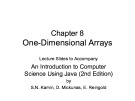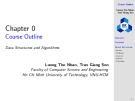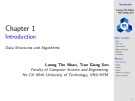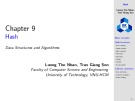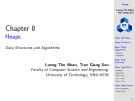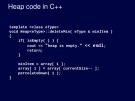
Lecture Algorithms and data structures
-
This document is an instructorís manual to accompany Introduction to Algorithms, Second Edition, by Thomas H. Cormen, Charles E. Leiserson, Ronald L. Rivest, and Clifford Stein. It is intended for use in a course on algorithms. You might also find some of the material herein to be useful for a CS 2-style course in data structures.
 429p
429p  haojiubujain08
haojiubujain08
 01-11-2023
01-11-2023
 1
1
 1
1
 Download
Download
-
Lecture An introduction to computer science using java - Chapter 8: One-dimensional arrays. In this chapter we will: introduce the array as a structure for storing large amounts of data, discuss common array operations, introduce algorithms for searching and sorting arrays, show how multiple images can be painted from an array to use in programming simple animations.
 29p
29p  haojiubujain04
haojiubujain04
 27-07-2023
27-07-2023
 8
8
 4
4
 Download
Download
-
Lecture An introduction to computer science using java - Chapter 14: Recursion. In this chapter we will: introduce recursion as a programming technique, show how recursion can be used to simplify the design of complex algorithms, present several well known recursive algorithms (e.g. quicksort, merge sort, Guaussian elmination), introduce the linked list data structure and recursive implementations for several of its methods, present programs for drawing two types of fractal curves.
 37p
37p  haojiubujain04
haojiubujain04
 27-07-2023
27-07-2023
 4
4
 4
4
 Download
Download
-
Lecture An introduction to computer science using java - Chapter 15: Text processing and file input/output. In this chapter we will: introduce recursion as a programming technique, show how recursion can be used to simplify the design of complex algorithms, present several well known recursive algorithms (e.g. quicksort, merge sort, Guaussian elmination), introduce the linked list data structure and recursive implementations for several of its methods, present programs for drawing two types of fractal curves.
 20p
20p  haojiubujain04
haojiubujain04
 27-07-2023
27-07-2023
 5
5
 4
4
 Download
Download
-
Lecture "Data structures and algorithms: Chapter 2 - Complexity of algorithms" provide students with knowledge about: Algorithm Efficiency; Big-O notation; Problems and common complexities; P and NP Problems. Please refer to the detailed content of the lecture!
 33p
33p  phuogchi205
phuogchi205
 07-03-2023
07-03-2023
 5
5
 5
5
 Download
Download
-
Lecture "Data structures and algorithms: Chapter 0 - Course outline" provide students with knowledge about: Introduction data structures and algorithms; Complexity of algorithms; Recursion; List: Array-List, Linked list; Stack, queue; Sorting; Heap;... Please refer to the detailed content of the lecture!
 12p
12p  phuogchi205
phuogchi205
 07-03-2023
07-03-2023
 7
7
 4
4
 Download
Download
-
Lecture "Data structures and algorithms: Chapter 1 - Introduction" provide students with knowledge about: Basic concepts: Data type, Data structure, Abstract data type, Algorithm, Pseudocode; Revision: Data structures, Classes, Pointers, Arrays, Pointers to structures, Pointers to classes. Please refer to the detailed content of the lecture!
 41p
41p  phuogchi205
phuogchi205
 07-03-2023
07-03-2023
 5
5
 4
4
 Download
Download
-
Lecture "Data structures and algorithms: Chapter 9 - Hash" provide students with knowledge about: Basic concepts; Hash functions: Direct Hashing, Modulo division, Digit extraction, Mid-square, Mid-square, Folding, Rotation, Pseudo-random; Collision resolution. Please refer to the detailed content of the lecture!
 58p
58p  phuogchi205
phuogchi205
 07-03-2023
07-03-2023
 6
6
 5
5
 Download
Download
-
Lecture "Data structures and algorithms: Chapter 10 - Sorting" provide students with knowledge about: Sorting concepts; Insertion Sort; Selection Sort; Exchange Sort; Devide-and-Conquer. Please refer to the detailed content of the lecture!
 63p
63p  phuogchi205
phuogchi205
 07-03-2023
07-03-2023
 7
7
 5
5
 Download
Download
-
Lecture "Data structures and algorithms: Chapter 3 - Recursion" provide students with knowledge about: Recursion and the basic components of recursive algorithms; Properties of recursion; Designing recursive algorithms; Recursion and backtracking; Recursion implementation in C/C++. Please refer to the detailed content of the lecture!
 48p
48p  phuogchi205
phuogchi205
 07-03-2023
07-03-2023
 7
7
 4
4
 Download
Download
-
Lecture "Data structures and algorithms: Chapter 4 - Lists" provide students with knowledge about: Linear list concepts; Array implementation; Singly linked list; Other linked lists; Comparison of implementations of list. Please refer to the detailed content of the lecture!
 100p
100p  phuogchi205
phuogchi205
 07-03-2023
07-03-2023
 6
6
 4
4
 Download
Download
-
Lecture "Data structures and algorithms: Chapter 5 - Stacks and queues" provide students with knowledge about: Basic operations of stacks; Implementation of stacks; Applications of stack; Basic operations of queues; Implementation of queue; Applications of queue. Please refer to the detailed content of the lecture!
 93p
93p  phuogchi205
phuogchi205
 07-03-2023
07-03-2023
 5
5
 4
4
 Download
Download
-
Lecture "Data structures and algorithms: Chapter 6 - Trees" provide students with knowledge about: Basic Tree concepts; Binary trees; Expression trees; Binary Search trees... Please refer to the detailed content of the lecture!
 62p
62p  phuogchi205
phuogchi205
 07-03-2023
07-03-2023
 5
5
 4
4
 Download
Download
-
Lecture "Data structures and algorithms: Chapter 7 - AVL Trees, B - Trees" provide students with knowledge about: AVL tree concepts; AVL balance; AVL tree operations; Multiway trees; B -Trees. Please refer to the detailed content of the lecture!
 82p
82p  phuogchi205
phuogchi205
 07-03-2023
07-03-2023
 6
6
 4
4
 Download
Download
-
Lecture "Data structures and algorithms: Chapter 8 - Heaps" provide students with knowledge about: Heap Definition; Heap Structure; Basic Heap Algorithms; Heap Data Structure; Heap Algorithms; Heap Applications. Please refer to the detailed content of the lecture!
 44p
44p  phuogchi205
phuogchi205
 07-03-2023
07-03-2023
 7
7
 4
4
 Download
Download
-
Lecture Object-Oriented programming - Lesson 41: Standard template library. The main topics covered in this chapter include: C++ programmers commonly use many data structures and algorithms; so C++ standard committee added the STL to C++ standard library; STL is designed to operate efficiently across many different applications;...
 38p
38p  linyanjun_2408
linyanjun_2408
 23-04-2022
23-04-2022
 14
14
 1
1
 Download
Download
-
Lecture Data Structures: Lesson 26 provide students with knowledge about huffman encoding; to understand Huffman encoding, it is best to use a simple example; encoding the 32-character phrase: "traversing threaded binary trees"; repeat the process down the left and right subtrees;...
 30p
30p  hanthienngao
hanthienngao
 15-04-2022
15-04-2022
 10
10
 1
1
 Download
Download
-
Lecture Data Structures: Lesson 31 provide students with knowledge about buildheap; the general algorithm is to place the N keys in an array and consider it to be an unordered binary tree; the following algorithm will build a heap out of N keys;...
 16p
16p  hanthienngao
hanthienngao
 15-04-2022
15-04-2022
 11
11
 1
1
 Download
Download
-
Lecture Data Structures: Lesson 32 provide students with knowledge about heap code in C++; buildheap in linear time; how buildHeap a linear time algorithm; complete binary tree; marking the left edges for height 1 nodes; marking the first left edge and the subsequent right edge for height 2 nodes;...
 16p
16p  hanthienngao
hanthienngao
 15-04-2022
15-04-2022
 14
14
 1
1
 Download
Download
-
Lecture Data Structures: Lesson 33 provide students with knowledge about priority queue using heap; the selection problem; a faster way is to put the N elements into an array and apply the buildHeap algorithm on this array; disjoint set ADT;...
 14p
14p  hanthienngao
hanthienngao
 15-04-2022
15-04-2022
 14
14
 1
1
 Download
Download
CHỦ ĐỀ BẠN MUỐN TÌM









